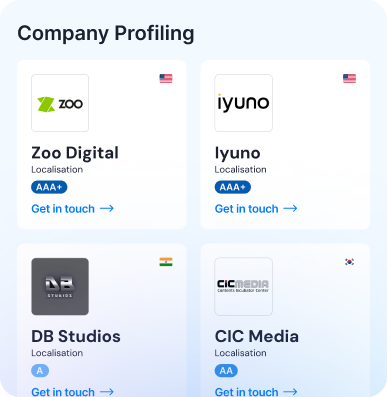Introduction
Television production is an expensive business, and networks are always looking for ways to share costs while producing high-quality content. One increasingly popular strategy is co-commissioning, where multiple broadcasters or platforms collaborate to finance and distribute a TV show.
But how does co-commissioning work? Who are the key players involved? And what benefits does this model offer to producers, networks, and distributors?
In this article, we’ll break down everything you need to know about co-commissioned TV shows, including:
- How networks share production costs
- The financial and creative advantages of co-commissioning
- Examples of successful co-commissioned TV shows
- Challenges involved in this approach
- How Vitrina helps networks, producers, and distributors find the right partners for co-commissioned projects
Whether you’re a content buyer, producer, or distributor, this guide will help you understand how to leverage co-commissioning to maximize reach, reduce financial risk, and create globally successful content.
Curious how Vitrina can help you? Try it out today!
Trusted by global entertainment leaders to grow business, acquire high-demand content, promote projects and services, and track every Film + TV production worldwide
Expand Your TV Content Reach with Vitrina

What is a Co-Commissioned TV Show?
A co-commissioned TV show is a project jointly funded and produced by two or more broadcasters, streaming platforms, or production companies. Unlike traditional commissioning, where a single network finances the project, co-commissioning allows multiple entities to pool resources, share risks, and secure broader distribution across different regions.
This strategy has gained momentum as networks seek cost-effective ways to produce premium content while expanding their global reach. Popular genres for co-commissioning include scripted dramas, documentaries, and large-scale factual entertainment.
How Does Co-Commissioning Work?
Co-commissioning typically follows a structured process:
1️⃣ Partnership Formation
- Networks, streamers, or production companies come together based on mutual content interests.
- Deals are brokered by producers, distributors, or market intermediaries like Vitrina.
2️⃣ Budget and Cost-Sharing
- Partners agree on production costs and how expenses will be split.
- Some parties contribute financially, while others offer distribution rights or marketing support.
3️⃣ Production & Creative Control
- The production is managed by a lead production company, with input from all co-commissioning parties.
- Creative decisions, editorial control, and localization strategies are pre-negotiated.
4️⃣ Distribution & Broadcasting
- Each co-commissioning partner gets exclusive or shared rights to air the content in their region.
- Some partners may pre-buy rights for a particular territory or audience segment.
Benefits of Co-Commissioning
✅ Financial Advantages
- Reduces financial burden on a single broadcaster.
- Allows for higher production quality with a larger combined budget.
✅ Wider Global Reach
- Ensures international exposure by securing multiple regional distribution deals.
- Helps content reach diverse audiences across markets.
✅ Access to Specialized Talent & Resources
- Enables collaborations with top-tier production houses and specialist service providers.
- Encourages diversity in storytelling with regional insights and expertise.
Secure Funding for Your Next TV Project

Challenges of Co-Commissioned Productions
Despite its advantages, co-commissioning comes with complexities:
❌ Creative Conflicts
- Different broadcasters may have varying content preferences, leading to disagreements.
❌ Rights & Revenue Distribution
- Legal frameworks can be complex when defining distribution rights, profit shares, and exclusivity terms.
❌ Logistical Coordination
- Managing multiple production schedules across different territories can be challenging.
Who Benefits from Film Project Tracking?
- Broadcasters & Streamers
- Identify content in early stages for acquisitions or pre-buys.
- Production & Post-Production Vendors
- Target projects needing services such as VFX, editing, or localization.
- Content Distributors
- Monitor projects nearing completion for potential licensing opportunities.
- Financiers
- Spot co-production and investment opportunities in projects with strong market potential.
Examples of Successful Co-Commissioned TV Shows
📺 “His Dark Materials” – BBC & HBO co-commissioned this high-end fantasy drama.
📺 “Planet Earth II” – BBC partnered with multiple networks globally to share costs.
📺 “The Night Manager” – A collaboration between BBC and AMC.
📺 “Criminal” – A unique police procedural co-commissioned by Netflix across multiple countries.
How Vitrina Helps with Co-Commissioned Projects
Finding the right co-commissioning partners can be challenging. Vitrina simplifies this process by:
🔹 Helping content creators and broadcasters identify and connect with potential co-commissioning partners.
🔹 Providing access to detailed company, content, and executive profiles.
🔹 Offering insights into market trends, financing models, and distribution strategies.
🔹 Facilitating introductions to decision-makers, executives, and industry stakeholders.
With Vitrina, you can efficiently qualify partners, negotiate deals, and expand your content’s global reach.
Key Takeaways
✔ Co-commissioning allows multiple networks to share production costs and risks.
✔ It enhances global reach and audience engagement.
✔ Challenges include creative differences, legal complexities, and logistical coordination.
✔ Vitrina helps producers and broadcasters find the right co-commissioning partners worldwide.
Frequently Asked Questions
Co-commissioning is when multiple networks jointly finance a project. Co-production involves production companies collaborating on content creation.
Networks assess content relevance, audience alignment, and financial viability before entering a co-commissioning deal.
Yes, many independent producers secure co-commissioning partners to fund and distribute their projects.































